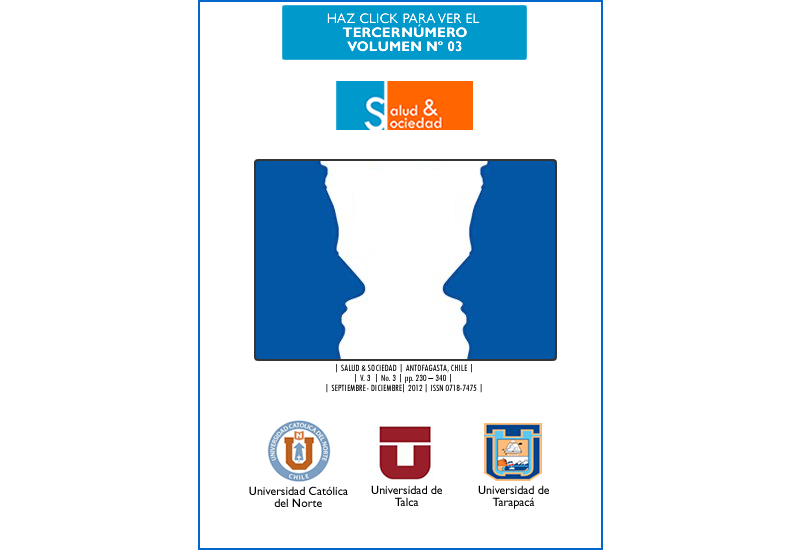Um estudo intracultural da consistência estrutural da escala multidimensional de reatividade interpessoal.
DOI:
https://doi.org/10.22199/S07187475.2012.0003.00002Palabras clave:
Empatia, modelagem estrutural, consistência, Empathy, structural modeling, consistency,Resumen
O presente estudo pretende verificar a consistência interna e estrutural da escala de empatia em quatro estados brasileiros. Dos variados instrumentos que avaliam a empatia, destaca-se a escala multidimensional de reatividade interpessoal de Davis (EMRI), a qual tem, não somente, um corpo teórico organizado, mas também, um instrumento operacionalizado para a mensuração do construto da empatia e que vem revelando bastante organizado e fidedigno quanto ao seu uso. A amostra foi composta por 899 sujeitos, do sexo masculino e do sexo feminino, de 14 a 61 anos, distribuídos no nível fundamental, médio e universitário de instituições privadas e publicas, nas cidades de João PessoaPB, Uberlândia-MG, Seropédica-RJ e Natal-RN. Os sujeitos responderam a Escala Multidimensional de Reatividade Interpessoal e dados sócio-demográficos. A partir de uma analise de equação e modelagem estrutural, observaram-se, em todas as amostras, indicadores psicométricos que garantiram a consistência estrutural da escala de reatividade interpessoal (EMRI) mensurada em quatro fatores, revelando assim, a segurança consistência empírica para o uso em brasileiros.
This study aims to verify the internal and structural consistency and of the empathy scale in four Brazilian states. Of the various instruments that assess empathy, the Davis Multi-Dimensional Scale of Interpersonal Reactivity (EMRI) stands out. It has an organized theoretical body as well as an operationalized instrument which measures the construct of empathy, and it has been found to be reliable and very well organized. The sample group consisted of 899 male and female subjects between the ages of 14 and 61 years old. All the subjects attended private and public primary, secondary, and college level educational institutions in the cities of João Pessoa-PB, Uberlândia-MG, Seropédica-RJ and Natal-RN. The subjects answered the Multidimensional Scale of Interpersonal Reactivity and socio-demographic data. Using equation analysis and structural modeling, ipsychometric indicators were observed in all samples. These indicators ensure the structural consistency of the Scale of Interpersonal Reactivity (EMRI) as measured by four factors, thus demonstrating assured empirical consistency when used with Brazilians.
Descargas
Referencias
Associação Nacional De Pesquisa E PósGraduação Em Psicologia - ANPEPP. (2000). Contribuições para a discussão das Resoluções CNS nº. 196/96 e CFP Nº 016/2000. Recuperado em 02 de Setembro de 2011, da WEB (página da WEB): http://www.anpepp.org.br/XIISimposio/Rel_ComissaoEticasobre_Res_CNS_e_CFP.pdf2000.
Batson, C. D.; Eklund, J. H.; Chermok, V. L.; Hoyt, J. L. e Ortiz, B. G. (2007). An additional antecedent of empathic concern: valuing the welfare of the person in need. Journal of Personality and Social Psychology, 93 (1), 65-74.
Batson, D. C.; Tricia, R. K.; Highberger, L. e Shaw, L. L. (1995). Immorality From Empathy-Induced Altruism: When Compassion and Justice Conflict. Journal of Personality and Social Psychology, 68 (6), 1042-1054.
Bilich, F.; Silva, R. e Ramos, P. (2006). Análise de flexibilidade em economía da informação: modelagem de equações estruturais. Revista de Gestão da Tecnologia e Sistemas de Informação, 3 (2), 93-122.
Byrne, B. M. (1989). A primer of LISREL: Basic applications and programming for confirmatory factor analytic models. New York: Springer-Verlag.
Camino, C. e Camino, L. (1996). Julgamento moral, emoção e empatia. In Z. D. Trindade & C. Camino (Eds.), Cognição social e juízo moral (Coletâneas da ANPEPP), (pp. 109-135). Rio de Janeiro: Associação Nacional de Pesquisa e Pós-graduação em Psicologia.
Cliffordson, C. (2001). Parent´s judgments and student´s self-judgments of empathy. European Journal of Psychological Assessment, 17, 36-47.
Conselho Nacional De Saude – CNS. (1996). Diretrizes e Normas Regulamentadoras de Pesquisas Envolvendo Seres Humanos. Recuperado em 02 de Setembro de 2011, da WEB (página da WEB):http://conselho.saude.gov.br/resolucoes/reso_96.htm. 1996.
Coplan, A. e Goldie, P. (2011). Empathy: Philosophical and Psychological Perspectives. Oxford: Oxford University Press.
Davis, M. H. (1983). Measuring individual differences in empathy: Evidence for a multidimensional approach. Journal of Personality and Social Psychology, 44, 113-126.
Decety J.; Michalska K. J. e Akitsuki, Y. (2008). Who caused the pain? A functional MRI nvestigation of empathy and intentionality in children. Neuropsychologia. 46, 2607–2614.
Decety, J. (2005). Perspective taking as the royal avenue to empathy. In: B. F. Malle e S. D. Hodges (Eds.), Other minds: How humans bridge the divide between self and other. (pp. 143–157). New York: Guilford Publications.
Decety, J. e Jackson, P. L. (2004). The functional architecture of human empathy. Behavioral and Cognitive Neuroscience Reviews. 3, 71–100.
DeCorte, K., Buysee, A., Verhofstadt, L., Roeyers, H., Ponnet, K. e Davis, M. (2007). Measuring empathic tendencies: Reliability and validity of the Dutch version of the Interpersonal Reactivity Index. Psichologica Belgica, 47 (4), 235-260.
Eisenberg, N. e Miller, P. A. (1987). The relation of empathy to prosocial and related behaviors. Psychological Bulletin, 101, 91–119.
Eisenberg, N. e Strayer, J. (1990). Empathy and its development. New York: Cambridge University Press.
Enz, N. e Zoll, N. (2006). Cultural differences in empathy between China, Germany and the UK. Recuperado em 23 de novembro de 2006, de www.nicve.salford.ac.uk/elvis/resources/empathy.
Escrivã, V. M. (2004). Measuring empathy: The Interpersonal Reactivity Index. Psicothema, 16 (2), 255-260.
Formiga, N. S.; Camino, C. e Galvão, L. (2009). Empatia, desenvolvimento moral e conduta desviante em adolescentes: testagem de um modelo teórico. In: VII Congresso Brasileiro de Psicologia do Desenvolvimento. (pp. 541-542). Rio de Janeiro, RJ: CBPD.
Formiga, N. S.; Galvão, L. K. S; Barboza, M. e Camino, C. (2012). Consistência estrutural da escala multidimensional de reatividade interpessoal: Um estudo com jovens civis e militares. Artigo submetido para avaliação.
Formiga, N., Rique, J., Galvão, L., Camino, C. e Mathias, A. (2011). Escala Multidimensional de Reatividade Interpessoal – EMRI: consistencia estrutural da versal reduzida. Revista Psicologia, Trujillo (Perú), 13(2), 188-198.
Galvão, L. (2010). Desenvolvimento moral e empatia: medidas, correlatos e intervenções educacionais. Tese de Doutorado, Universidade Federal da Paraíba. Disponível em http://bdtd.biblioteca.ufpb.br/tde_busca/arquivo.php?codArquivo=1086. Acesso em Julho de 2012.
Galvao, L.; Camino, C.; Gouveia, V. V. e Formiga, N. S. (2010). Proposta de uma medida de empatia focada em grupos: Validade fatorial e consistencia interna. Psico, 41 (3), 399-405.
Hair, J. F.; Tatham, R. L.; Anderson, R. E. e Black, W. (2005). Análise Multivariada de Dados. Porto Alegre: Bookman.
Håkansson, J. (2003). Exploring the phenomenon of empathy. Doctoral dissertation. Stockholm University, Department of Psychology, Stockholm.
Hoffman, M. L. (2000). Empathy and moral development: Implications for caring and justice. New York: Cambridge University Press.
Hogan, R. (1969). Development of an Empathy Scale. Journal of Consulting and Clinical Psychology, 33, 307-316.
Joreskög, K. e Sörbom, D. (1989). LISREL 7 user's reference guide. Mooresville: Scientific Software.
Kazmierczak, M., Plopa, M. e Petowski, S. (2007). Empathic sensitiveness scale. Przeglad Psychoogiczny, 50 (1), 9-24.
Mehrabian, A. e Epstein, N. (1972). A measure of emotional empathy. Journal of Personality, 40, 525-543.
Perez-Albeniz, A., De Paúl, J., Etxeberría, J., Montes, M. P. e Torres, E. (2003). Adaptación de Interpersonal Reactivity Index (IRI) al español. Psicothema, 15, 267-272.
Ribeiro, J.; Koller, S. H. e Camino, C. (2002). Adaptação e validação de duas escalas de empatia para uso no Brasil. Estudos de psicologia, 18 (3), 43-53.
Sampaio, L. R.; Camino, C. P. S. e Roazzi, A. (2009). Revisão de aspectos conceituais, teóricos e metodológicos da empatia. Psicologia: ciência e profissão, 29 (2), 212-227.
Sampaio, L. R.; Guimarães, P. R. B.; Camino, C. P. S; Formiga, N. S. e Menezes, I. G. (2011). Estudos sobre a dimensionalidade da empatia: tradução e adaptação do Interpersonal Reactivity Index (IRI). Psico, 42 (1), 67-76.
Sampaio, L. R.; Monte, F. C.; Camino, C. e Roazzi, A. (2008). Justiça distributiva e empatia em adolescentes do nordeste brasileiro. Psicologia: Reflexão e Crítica, 21 (2), 275-282.
Siu, A. M. H., e Shek, D. T. L. (2005). Validation of the Interpersonal Reactivity Index in a Chinese Context. Research on Social Work Practice, 15(2), 118-126.
Tabachnick, B. G. e Fidell, L. S. (1996). Using multivariate statistics. Needham Heights, MA: Allyn & Bacon.
Van De Vijver, F. e Leung, K. (1997). Methods and data analysis for crosscultural research. Thousand Oaks, CA: Sage Publications.
Wispé, L. (1990). History of the concept of empathy. In: N. Eisenberg & J. Strayer (org), Empathy and its development. (pp 17-37). New York: Cambridge University Press.
Descargas
Publicado
Número
Sección
Licencia
Los autores continúan como propietarios de sus trabajos, y pueden volver a publicar sus artículos en otro medio sin tener que solicitar autorización, siempre y cuando indiquen que el trabajo fue publicado originariamente en Revista Salud & Sociedad (ISSNe:0718-7475).



_(1).png)





